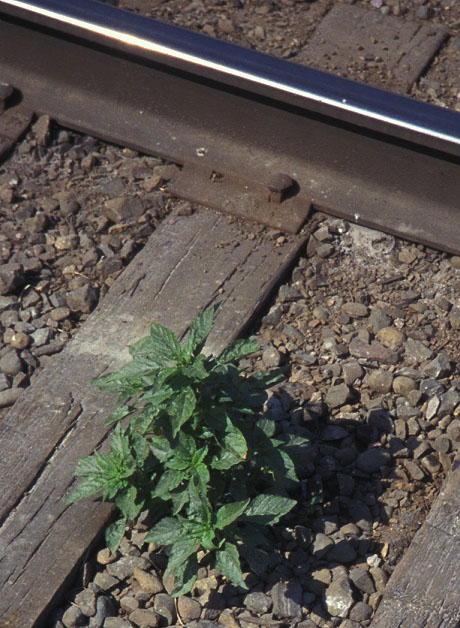
|
| Green Amaranth; Amaranthus Powellii S. Watson |
Amaranth Family; AMARANTHACEÆ
|
| Amaranth is a general name, quite equivalent to vetch, clover or mustard. For our present purposes, the common summertime weed
of local gardens may be called Green Amaranth. Other names applied to it include Redroot, Beet-root, Redroot Amaranth, and Pigweed. |
| The name Amaranthus is derived from the Greek amarantos, unfading, in allusion to the persistent, often riotously
colorful flowers and seed clusters of many species. All amaranths are New World natives. Curiously, at most 20% of Seattle's weeds are New World natives; the vast majority are invaders from Europe. Some amaranths are grown as garden ornamentals
(e.g., Love lies bleeding, Prince's feather), and some are raised for grain or as salad vegetables. In theory, all species of the genus are edible. |
| In Seattle several species of Amaranthus grow wild, but only A. Powellii is very common. It is predictable in sunny
summer gardens and compost heaps, growing often with lambsquarters (also called pigweed), lady's thumb, chickweed, purslane, barnyard
grass, etc. It doesn't become prominent until June or July, and lasts until frost. |
| It is anything but glamorous. There is nothing graceful or elegant about it. The swollen root and lower portion of its stem
are often blushed red or pink. The leaves are more or less shaped like tablespoons, and their undersides are shiny, with prominent
whitish veins. The whole plant is lightly hairy. Flowers are minute and congested in upright greenish clusters, from July into October.
Shiny black seeds ensue. It usually grows 1 to 6 feet tall. Best growth is in disturbed soil, preferably garden conditions: loose, rich and
moist soil warmed by much sunshine. |
| Green Amaranth is not an especially injurious weed; it is more of a nuisance or eyesore. You can easily yank it up before
it goes to seed. I eat it regularly raw or cooked. Its flavor is not as memorable as that of purslane, sheep sorrel, or even
lambsquarters, but is still superior to smartweed or fireweed (damning with faint praise). I find it a good plain bulk green, about like vetch,
chickweed or mallow in this regard. In salads, generously spice it with more exciting flavors. Or cook it with olive oil, garlic, salt or
whatever you like to enliven your greens. |
| Since it is in a plant family unto itself (and not one of the few from which most of us obtain most of our nutrition),
amaranth may offer some unique value to our diet. At the least, it is a remarkable source for the amino acid lysine. |
| The name Green Amaranth can be taken not only to indicate this species being quite
green compared to many reddish-leaved or flowered species, but also to highlight that it is better eaten as a green vegetable than treated as a
grain amaranth. Its seeds, though edible, are awkwardly tiny. |
All in all, Green Amaranth is not especially flavorful, is not good looking, nor is it a weed horror to write home about. It
is chiefly of interest as a wild summer vegetable for folks who like to eat some of the weeds they pluck from their gardens.
|
Originally published as the Seattle Tilth newsletter Weed of the Month in July 1995, along with an illustration from a book.
Back |
|
|

